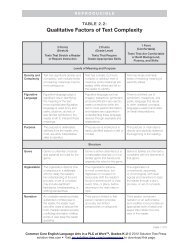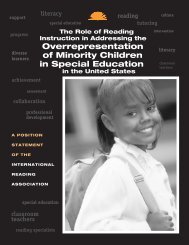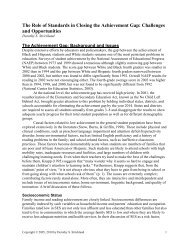Global Education Digest 2012 - International Reading Association
Global Education Digest 2012 - International Reading Association
Global Education Digest 2012 - International Reading Association
Create successful ePaper yourself
Turn your PDF publications into a flip-book with our unique Google optimized e-Paper software.
OPPORTUNITIES LOST: THE IMPACT OF GRADE REPETITION AND EARLY SCHOOL LEAVING<br />
schooling. The UIS disaggregates these children<br />
according to their exposure to education: those who<br />
have left school, those who are expected to enter<br />
school in the future and those who are expected to<br />
never attend school.<br />
<strong>Global</strong>ly, 47% of all out-of-school children of primary<br />
school age will probably never enter school. A further<br />
26% have attended school but dropped out, and<br />
the remaining 27% are expected to enter school<br />
in the future. Data show large variations in regional<br />
patterns. In the Arab States, Central Asia, South and<br />
West Asia and sub-Saharan Africa, about one-half<br />
of all out-of-school children will probably never enter<br />
school. In Central and Eastern Europe, Latin America<br />
and the Caribbean and North America and Western<br />
Europe, most out-of-school children will start school<br />
late. East Asia and the Pacific and South and West<br />
Asia have large shares of early school leavers.<br />
These data on different categories of out-of-school<br />
children highlight two central points relevant to<br />
this analysis. First, roughly 28 million children will<br />
not benefit from access to schooling, despite the<br />
improvements made over the past decade. It is<br />
therefore imperative – albeit difficult – to identify who<br />
these disadvantaged children are in order to design<br />
programmes that will be more effective in reaching<br />
them. Second, most children who are currently out of<br />
school will either start late (by exceeding the intended<br />
school entry age) or have left school early. So, in<br />
order to reduce the risk of early school leaving and<br />
the number of children out of school, it is essential to<br />
focus more attention on what is actually happening<br />
in schools and how this affects children’s chances of<br />
staying in school and progressing through the system.<br />
1.2 WHEN ARE CHILDREN MEANT TO<br />
ENTER SCHOOL? HOW LONG ARE THEY<br />
SUPPOSED TO STAY IN SCHOOL?<br />
How long are children meant to be in school? What<br />
are the legal regulations for compulsory schooling<br />
and how are education systems designed in terms<br />
of intended age coverage? The UIS collects data on<br />
compulsory education according to the age span<br />
and grades during which children and young people<br />
are legally obliged to attend school. These legal<br />
measures aim to assure that children and young<br />
people in a given country receive a minimum amount<br />
of education (even if they repeat grades) and do not<br />
leave school early.<br />
Many governments acknowledge the right to<br />
education in their national constitutions and through<br />
the signing of international treaties. Often, laws are<br />
enacted that obligate citizens in a certain age span to<br />
attend school. Furthermore, countries may guarantee<br />
these rights by offering tuition-free public education<br />
to their citizens, especially for certain grades or levels<br />
of education.<br />
The intended age for school entry varies by region<br />
(see Figure 2). Primary education is nearly always<br />
compulsory. It typically begins between the ages of<br />
5 and 7 years, with 6 years as the most common<br />
entry age. Yet in some countries, especially in Latin<br />
America and the Caribbean, compulsory education<br />
may even begin before primary education, starting<br />
as early as age 3. The regions with the latest starting<br />
ages for compulsory education in 2010 were Central<br />
Asia and Central and Eastern Europe (over 45% of<br />
countries begin primary education at age 7). In sub-<br />
Saharan Africa, more than two-thirds of countries<br />
begin compulsory education at age 6 or earlier, and<br />
the rest begin at age 7.<br />
In line with various international declarations and<br />
conventions on the right to education 1 , compulsory<br />
education typically begins with primary education.<br />
In 2010, lower secondary education was part of<br />
compulsory education in three out of four countries<br />
reporting data, and laws on compulsory education<br />
now include all or part of upper secondary education<br />
in just over one in four countries worldwide. Lower<br />
secondary education is part of basic education<br />
(according to ISCED 1997). Increasingly it is seen<br />
as part of compulsory education. The UNESCO-<br />
1 For example, the Universal Declaration of Human Rights, Article 26:<br />
www.un.org/en/documents/udhr/ and the UN Convention on the Rights of<br />
the Child, Article 28: www2.ohchr.org/english/law/crc.htm<br />
11

















